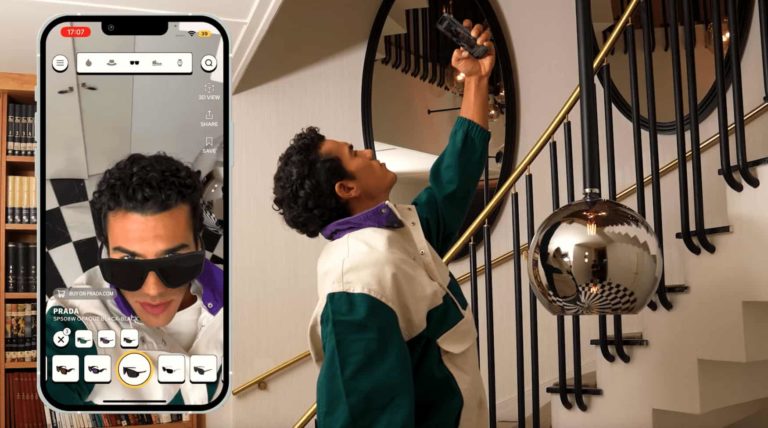
The technology for widespread 3D models and virtual try-on (VTO) is here. The adoption is not. This is the problem we are trying to solve with our new virtual try-on app – TRYO.
There are other experiences and apps out there for virtual try-on, but they are focused on a specific technology (foot tracking for shoes, say), are brand specific, or are part of a much larger suite of features (Snapchat). My company QReal comes at this from the 3D modeling side. We make the highest quality optimized 3D models and can do it at scale. We wanted to create a pure-play AR shopping app that was multi-brand, multi-category, and used the best tech available to showcase the power of 3D models and VTO.
TRYO provides users with a one-stop shopping experience with the ability to virtually try on footwear, watches, hats, and eyewear, with new brands and products added weekly. TRYO is creating a vast library of 3D branded models, with over 500 items at launch (including products from Cartier, Gucci, Adidas, New Era, to name a few), and new items added weekly. We partnered with Wanna Fashion to use their excellent foot and wrist tracking technology and built the face tracking on Apple’s ARKit. Best virtual try-on tech – check; best 3D models, at scale – check.
https://youtu.be/TN807LaSBwM
We think it’s rad, try it out. We also think it’s useful. I might be preaching to the choir here, but let me share some stats. While online sales accounted for $1.050 trillion of total U.S. retail sales last year, approximately $218 billion of online purchases were returned, as it’s difficult for shoppers to truly know how an item will fit or look without first trying it on. A study by Snap shows that 66% of shoppers who use augmented reality tech are less likely to return items. In the same study, 80% of respondents said they feel more confident in their purchases when using augmented reality tools. And Google, which is rolling out 3D models directly in Search, claimed that 3D models improved engagement by 50% over traditional images.
Google’s move to 3D in Search, plus the higher engagement, means that a brand’s absolute top-of-the-funnel will be a 3D model. Therefore, the asset has to be perfect, you have to be able to make gobbles of them, and they can’t be cost-prohibitive. Now we can get into the business side of TRYO, for which the app is a showcase.
3D models are different from product photography in that a single model can serve the same function on all sites, despite design differences. The catalog created for TRYO is meant to be distributed to multiple brands and retailers to spread the cost of 3D production throughout the sales channels. It’s a Universal 3D model. 3D adoption has been slowed by large upfront costs to produce high-quality models. The TRYO catalog of ultra-realistic branded items is meant to significantly lower the costs for any brand or retailer to adopt 3D on a product display page or virtual try-on.
Currently, a single company is forced to foot the bill for a large catalog of assets. It can easily be 6 figures. Those assets are then siloed on whatever platforms they were created for (a single brand’s Product Display Page, say). But that brand probably sells through many different channels and retailers. The 3D asset would increase sales across all of them, but the brand foots the bill and very well might not be able to power the retailers’ sites at all with them due to file size restrictions, file types, formatting, etc. QReal’s Universal 3D models are meant to be distributed to multiple sales channels and disperse the cost, since everyone will benefit from their usage.
Brands or retailers can either license whatever SKUs they want from the existing catalog, or “launch” a new model for the catalog. QReal will create many models on its own, but when a client requires an SKU not available, they can request it for the platform, pay a very small upfront fee and waive any licensing fees for a year. This incentivizes brands or retailers to improve the catalog. By our estimations, a brand or retailer will be able to power a model on their site for 2-4 years before they hit the upfront pricing for high-quality modeling, reaping all the upside along the way.
An astute observer might be questioning the ownership of the assets and questioning whether brands or retailers will cede this issue. We don’t think these entities will really want to own their assets, when considered thoughtfully. The platforms aren’t completely set for the long haul, so a change in iOS, say, can affect lighting, HDRI, or many other aspects, which will then be incumbent on the hoster to fix. And exclusive ownership means that one must incur all the costs and limit the benefits from different sales channels. If they want to use the assets for other Metaversy things, QReal can accommodate that as well. Companies and people get used to paying for services that they don’t have to intimately manage. Due to the universal nature of a 3D asset, we believe this will become the norm as well.
TRYO started with hats, sunglasses, shoes, and watches because these items are currently the best for try-on. We think they came out beautifully, but it’s just the beginning. Let us know.
 Mike Cadoux is General Manager of QReal.
Mike Cadoux is General Manager of QReal.

